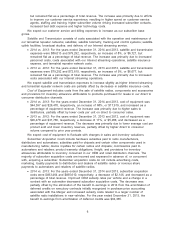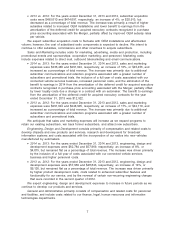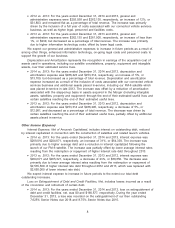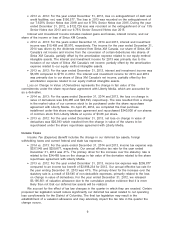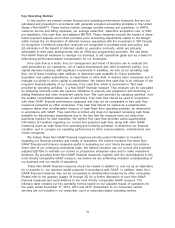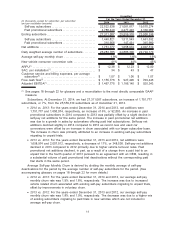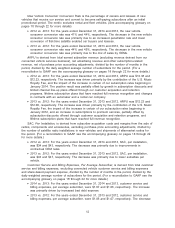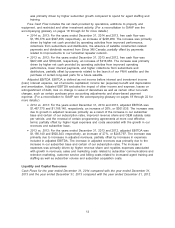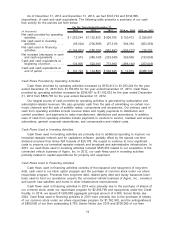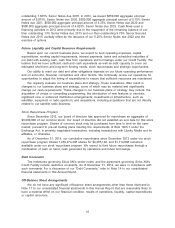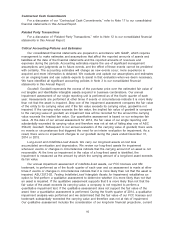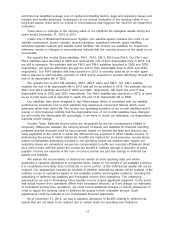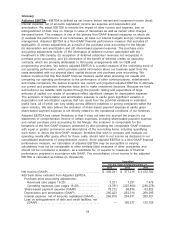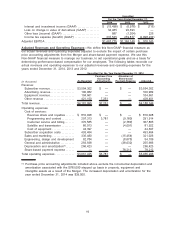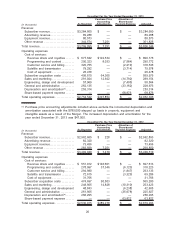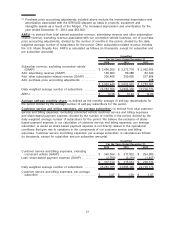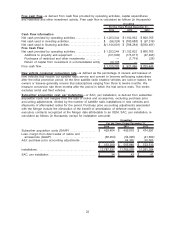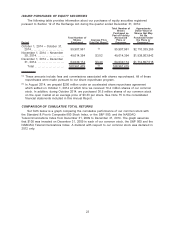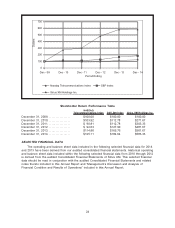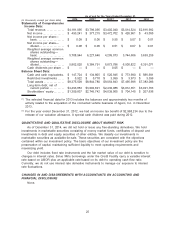XM Radio 2014 Annual Report Download - page 97
Download and view the complete annual report
Please find page 97 of the 2014 XM Radio annual report below. You can navigate through the pages in the report by either clicking on the pages listed below, or by using the keyword search tool below to find specific information within the annual report.Contractual Cash Commitments
For a discussion of our “Contractual Cash Commitments,” refer to Note 17 to our consolidated
financial statements in this Annual Report.
Related Party Transactions
For a discussion of “Related Party Transactions,” refer to Note 12 to our consolidated financial
statements in this Annual Report.
Critical Accounting Policies and Estimates
Our consolidated financial statements are prepared in accordance with GAAP, which requires
management to make estimates and assumptions that affect the reported amounts of assets and
liabilities at the date of the financial statements and the reported amounts of revenues and
expenses during the periods. Accounting estimates require the use of significant management
assumptions and judgments as to future events, and the effect of those events cannot be predicted
with certainty. The accounting estimates will change as new events occur, more experience is
acquired and more information is obtained. We evaluate and update our assumptions and estimates
on an ongoing basis and use outside experts to assist in that evaluation when we deem necessary.
We have identified all significant accounting policies in Note 3 to our consolidated financial
statements in this Annual Report.
Goodwill. Goodwill represents the excess of the purchase price over the estimated fair value of
net tangible and identifiable intangible assets acquired in business combinations. Our annual
impairment assessment of our single reporting unit is performed as of the fourth quarter of each
year. Assessments are performed at other times if events or circumstances indicate it is more likely
than not that the asset is impaired. Step one of the impairment assessment compares the fair value
of the entity to its carrying value and if the fair value exceeds its carrying value, goodwill is not
impaired. If the carrying value exceeds the fair value, the implied fair value of goodwill is compared
to the carrying value of goodwill; an impairment loss will be recorded for the amount the carrying
value exceeds the implied fair value. Our quantitative assessment is based on our enterprise fair
value. At the date of our annual assessment for 2014, the fair value of our single reporting unit
substantially exceeded its carrying value and therefore was not at risk of failing step one of ASC
350-20, Goodwill. Subsequent to our annual evaluation of the carrying value of goodwill, there were
no events or circumstances that triggered the need for an interim evaluation for impairment. As a
result, there were no impairment charges to our goodwill during the years ended December 31,
2014 or 2013.
Long-Lived and Indefinite-Lived Assets. We carry our long-lived assets at cost less
accumulated amortization and depreciation. We review our long-lived assets for impairment
whenever events or changes in circumstances indicate that the carrying amount of an asset is not
recoverable. At the time an impairment in the value of a long-lived asset is identified, the
impairment is measured as the amount by which the carrying amount of a long-lived asset exceeds
its fair value.
Our annual impairment assessment of indefinite-lived assets, our FCC licenses and XM
trademark, is performed as of the fourth quarter of each year and an assessment is made at other
times if events or changes in circumstances indicate that it is more likely than not that the asset is
impaired. ASU 2012-02, Testing Indefinite-Lived Intangible Assets for Impairment, establishes an
option to first perform a qualitative assessment to determine whether it is more likely than not that
an asset is impaired. If the qualitative assessment supports that it is more likely than not that the
fair value of the asset exceeds its carrying value, a company is not required to perform a
quantitative impairment test. If the qualitative assessment does not support the fair value of the
asset, then a quantitative assessment is performed. During the fourth quarter of 2014, a qualitative
impairment analysis was performed and we determined that the fair value of our FCC licenses and
trademark substantially exceeded the carrying value and therefore was not at risk of impairment.
Our qualitative assessment includes the consideration of our long-term financial projections, current
16


